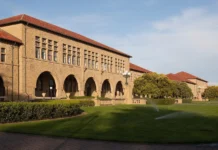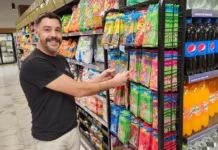A yellow teddy bear hangs from the ceiling. With a patterned parachute attached to its tiny body, it hangs, midflight, amid a cacophony of other creatures like a stuffed lion, a stuffed moose, a stuffed tiger, and even a tiny stuffed devil, who all seem to be making their way safely to the ground. There, perhaps, they will meet up with their other friends, hundreds of stuffed creatures that have been attached to walls, sconces, windows, and more in Charlemagne Palestine’s new immersive exhibition, Bear Mitzvah in Meshugahland at The Jewish Museum.
Bear Mitzvah in Meshugahland is the artist’s first museum exhibition in the United States since his move to Brussels in the 1980s. It features not just the stuffed paratroopers on the perimeter of the space, but “Noah’s Ark,” a yellow boat—one Palestine said he found discarded at Montauk, New York, and brought with him to Belgium when he moved—tilted as if crashing into a wave. It is overflowing with plush friends and marooned on a platform covered in a blanket of colorful fabric swaths. There is also a “bear” mitzvah, a diorama in which a young ginger bear becomes a man, holding a Torah and cloaked in tallis, a rainbow-embroidered yarmulke affixed to the top of his head; and a minyan of patterned bears close by. Disco balls spin at different levels, casting revolutions of white specks in the space as Palestine’s droning, tonal, experimental sound compositions pump through speakers. It’s a mind-blasting experience to be there, perhaps sanctuarial or overwhelming or both, depending on who you are.
Mounting the exhibition at the space has been a four-and-a-half-year process, with conversations beginning in 2012 to actual installation this month. Jewish Museum chief curator Norman Kleeblatt said the work doesn’t fit typical installation tropes. “A lot of contemporary work that has been called by [art historian] Claire Bishop ‘immersive installations’ have had a hint of gloom or tragedy, and this is the flipside. There’s also a mystical element in the delight instead of the tragic,” he said. “I think the most important thing is to let the show envelop you,” Kleebatt told me. “It’s an experiential piece first, and then—after you’ve really let yourself be embraced, wrapped up, delighted, annoyed, mystified—then you may want to ask questions.”
Questions about the role stuffed animals play in Palestine’s life, or your own life. Questions about the idea of childhood, and if it’s ever really lost. Or as you wander around the installation, about where to even begin asking questions in the first place.
***
Palestine, now 69, is predominantly known for his sound compositions, which grew out of the same 1960s experimental and avant-garde soundscape inhabited by the likes of Philip Glass, LaMont Young, Tony Conrad, and John Cale. In Palestine’s most well-known compositions, the “Strumming Music” collection, keys or strings are manipulated in two alternating tones for hours; a box set rereleased in 2010, Strumming Music for Piano, Harpsichord and String Ensemble, features live performances of this work from the 1970s. In this particular installation at the Jewish Museum, the sounds might feel like more of a backdrop but for Palestine, the experience of this installation, and his work in general, is best related as the Wagnerian concept of Gesamtkunstwerk, the viewing of one’s oeuvre as a comprehensive, total work of art.
As a roving college student, Palestine was heavily influenced in both his sound and installation work by Folkways recordings, for which anthropologists and ethnomusicologists would travel around the globe recording folk, world, and children’s music. “In the time of the hippies, the ’60s, we would all very much fall in love with all kinds of alternative cultures from the East, from India, from Indonesia, and I was totally in that,” Palestine told me recently outside of his exhibition. He sported a long gray ponytail to his nape, scruffy gray stubble, and a black baseball cap embroidered with fire and rhinestones, all over a fluffy red winter jacket with a mélange of colored scarves.
From the cultures exposed to him via Folkways, Palestine also learned the importance of divinity in physical form. “A little object, a shamanic object, it can be something so important. That totally exploded my imagination,” he said. “I needed that kind of tactile relationship to everything. I’m a very tactile person. That became my modus operandi in all that I did, with the animals, with sounds, with cultures.” Perhaps accordingly, Palestine referred to stuffed animals as divinities, objects that show “the possibility of animating your life and helping you see it another way, where you’re not discarded at a certain moment,” as everlasting talismans that perpetuate an existence.
The exhibition itself is a salute to Palestine’s Jewish roots and the teddy bear’s oft-unknown Jewish history. While many are aware the teddy bear was named in 1902 when President Theodore “Teddy” Roosevelt refused to shoot a bear that had been captured for him, not many know that the first teddy bear was reputedly made by Rose and Morris Michtom, a Jewish couple who by day owned a candy store in Bedford-Stuyvesant, Brooklyn, and by night made stuffed animals. After seeing illustrator Clifford Berryman’s famous cartoon in the Washington Star, the couple was inspired to create a stuffed toy bear and named it after the president. When the Michtoms wanted to make a series of bear cubs, which they wanted to call “Teddy’s Bear,” they wrote to Roosevelt himself for approval, and the president granted his permission. The Michtoms placed the teddy bear in their candy-shop window in 1903 and sales were so strong they started the Ideal Toy Co. in 1907, which became a multimillion-dollar business for decades and eventually merged with Mattel.
Palestine, born to a secular Jewish family not far from Bedford-Stuyvesant in the adjoining neighborhood of Brownsville, didn’t learn of the teddy bear’s Jewish background until the late 1980s. Palestine felt as if destiny—or, in his words, “a spooky Jewish spookiness”—had intervened: By that point, he had been experimenting with stuffed animals as a medium since the late 1960s. How strange that he should find out about this while working on the handmade, oversize stuffed-animal sculpture bear with three heads and two bodies for 1987’s Documenta 8, the eighth iteration of the quinquennial contemporary art exhibition in Kassel, Germany—from an employee and family member of the luxury German stuffed-animal company Steiff, no less.
Palestine, born Chaim Moshe Tzadik Palestine in 1947 to Eastern European immigrant parents, had stuffed animals like any child growing up at the time, and even used them to communicate with his parents when he had trouble talking to them because of a stutter. To manage the stutter, Palestine began singing with the Stanley Sapir Jewish choir and eventually became a trained cantorial singer while also studying accordion and piano.
At 11 years old, he still kept his “friends,” as he called his stuffed animals, close by, and his mother became concerned, eventually throwing them out. Palestine later described the experience to BOMB magazine as “a great crisis.”
Or so Palestine thought. On a family trip to Rockaway Beach, however, the car got a flat tire and his father went to the trunk to get a spare. Inside were all of young Chaim’s stuffed friends, much to his mother’s chagrin. Hadn’t she told Chaim’s father to throw them away? But his father couldn’t part with them. Seeing the animals again, Palestine’s heart mended. But it was only for a short time—his mother would throw out the stuffed animals again before his bar mitzvah, and three months later his father died. He’d never see his stuffed animals again.
Well, he’d never see those stuffed animals again. The story obviously doesn’t end there. While working at the California Institute of the Arts just outside Los Angeles, a girlfriend gave him a bear with blue eyes from a St. Vincent de Paul thrift shop. He would call this bear “King Teddy,” and his love for stuffed animals was rekindled. King Teddy “used to say things like ‘Yyyaahh,’ ” Palestine said. “That’s actually a quote from my early King Teddy. [The stuffed animals] used to actually speak with me, and I used to do early performances where I had interactions with these animals and they actually, we had dialogues.” Palestine began to amass a great collection of stuffed animals, rescuing them from “orphanages” (thrift shops) all over the world to create installations.
Palestine refers to this work with stuffed animals as “meshugah,” the Yiddish word for “crazy.” It was a word his grandfather used to describe him growing up, but to mean foolish or insane, not in the endearing way it’s used today. “I think if he were alive, he would be shocked, he would say that people are really meshugah to think that my meshugah is so important,” Palestine said.
His mother came from a family of textile workers—“the schmatta side,” as he called it, and his father was a plastering contractor, but young Chaim’s interest in the arts grew while singing to manage his stutter. As a teenager, he auditioned for The High School of Music and Art (now the Fiorello H. LaGuardia High School of Music and Art and Performing Arts) in Manhattan, then in Harlem on 137th Street and St. Nicholas Avenue, and was accepted. Except by that time his family had moved to the Sheepshead Bay neighborhood of Brooklyn, over an hour commute from the high school, so Palestine’s mother rented him a studio apartment on 105th Street and Broadway to shorten the trip.
“My life changed,” Palestine said. “I was around all kinds of experimentation, where just a few years before I was in the boonies.” He began spending time with students (specifically girls) who were not just performers like himself, but visual artists, and developed an interest in both realms. He played conga and bongo drums for poets like Gregory Corso and Allen Ginsberg. He also rang carillon bells at St. Thomas Episcopal Church in Manhattan—where, incidentally, he began experimenting and making unusual sounds much to the church’s dismay, but they couldn’t fire him because an executive at CBS in a nearby building loved it and commanded the church to keep him—and had a membership card to the Museum of Modern Art next door. He saw and heard alternative compositions on a regular basis, and the influence stayed with him throughout his life. After high school, Palestine studied at six different universities in eight years, from the Mannes School of Music at the New School, to Pratt University, to NYU and more, touching on not just arts but psychology and sociology as well.
At NYU, he met experimental filmmaker and kinetic sculptor Len Lye who, 40 years his senior, became Palestine’s mentor and welcomed the young man to assist on his sculptures. Palestine also studied vocal interpretation with Hindustani classical singer Pandit Pran Nath, would later compose light and sound experiments for choreographer Simone Forti, and teach at CalArts, where the aforementioned King Teddy ended up in his hands. In the 1970s, Palestine began performing his sound experiments with a multitude of stuffed animals, all crowded into his instrument of choice, usually an organ or piano (preferably a Bösendorfer Imperial, the world’s loudest, largest concert piano). In the 1980s, he exhibited his installation work at European contemporary-art museums like the Stedelijk in Amsterdam and Modern Museet in Stockholm, and at Documenta. He still performs and exhibits all over the world, most recently at the Witte de With Center for Contemporary Art in Rotterdam and the Kunsthalle Wien in Vienna, and is listed by musicians like Nick Cave and Sonic Youth’s Thurston Moore as an influence.
The search for alternative ritual is a prevalent theme in Palestine’s life and work that’s colored by his experiences as a child. For example, where stuffed animals were meant as a toy to cuddle, he used them to communicate; where music was meant to be sung, he used it to overcome a stutter. It only makes sense, then, that he would view these aspects of his world in terms of unconventional usage and make the pursuit of such unconventionality his calling card. “That’s what my works have always done … the ritual that I do with an organ, even though it’s a church, I’m a Jew, I treat it like it some kind of ancient Mesoamerican temple so I mix all these things up together and that’s [typical] of me, in my generation,” he said. “I think there were others who did it in a different way. I’ve mixed all these different things into a big bouillabaisse, a sacred bouillabaisse.”
In some ways, Palestine’s work is also a meditation on legacy, a rebellion against a culture and a life that wants to, and actively does, discard us. As a stuttering child, losing his stuffed animals meant losing a way to communicate, a way to express and be himself. It’s almost as if since then he’s been trying to fix that, to maintain a voice and a sense of self and to make sure there will always be something to speak for him, even if it’s long after he’s gone. A way to say, “You cannot throw me out. Look at all the ways I exist.”
“My mother, later on, I began to invite her to my Documenta and my big presentations all over the world,” Palestine said. “I would always tell the story that my mother threw [my stuffed animals] out and this is revenge, and so she would laugh and everybody else would laugh too, but it was somehow true that it was just my destiny.”
Charlemagne Palestine’s Bear Mitzvah in Meshugaland is on view at the Jewish Museum through August 6, 2016
























